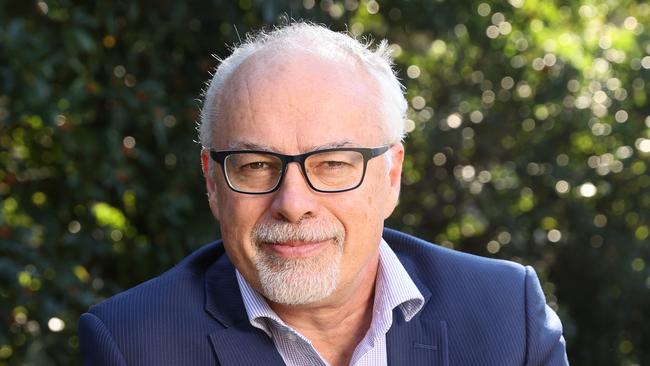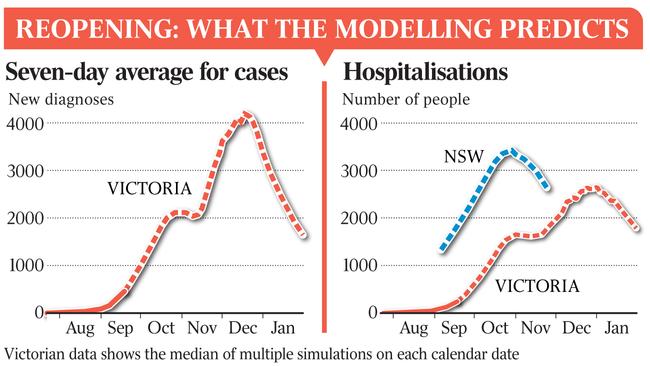
At the beginning of August, the Burnet Institute, which has been commissioned by the NSW and Victorian governments to provide modelling to inform their road maps for opening up, was predicting there would be 7000 cases a day in NSW. The number ended up being only about 1200 a day.
Now the Burnet Institute is predicting a peak seven-day average of 4543 cases in Victoria come January and somewhere between 1455 and 3152 deaths between September and the end of December.
How can that be when NSW, whose cases so far have peaked at about 1500 infections a day, has recorded only 245 deaths so far during its Delta wave?
One explanation has now emerged for why Burnet’s case and fatality estimates for Victoria are so high. In its estimate of deaths, Burnet made an assumption that the death rate from Delta is double that of the original strain of the virus. It may prove to be the case, but it has yet been established by the available evidence worldwide.
Burnet’s case projections were also based on the rate of the exponential rise in cases during the past few weeks, whereas the rise in cases has already begun to slow.
Based on these factors, Tony Blakely, whose School of Population and Global Health at the University of Melbourne has just released some new modelling of its own, believes Burnet’s estimates of cases and fatalities are too high.

“The modelling is really good, but I think the estimates are too high,” he said. “They use that two-fold higher mortality and morbidity rate. They may well be correct on that, I don’t know yet, but I’m pretty confident that we’ll improve our treatments, and even if it is two-fold higher without those new treatments, the mortality rate will go back to something like it used to be.”
The Burnet Institute predicts that there is a 58 per cent chance that Covid-19 cases in Victoria will exceed the state’s hospital and ICU capacity. It predicts ICU cases to peak at 706, with a peak of 3150 hospitalisations.
The model predicts that based on the current epidemic growth rate, a peak in seven-day average daily diagnoses of 1400 to 2900 is estimated to occur between October 19 and 31, and there will be a second peak in mid-December.
Professor Blakely’s modelling predicts that under a default scenario of 80 per cent vaccine coverage of people aged over 16, there would be 320 infections per day, 4000 hospitalisations, 860 ICU admissions and 1000 deaths over the course of 2022.
However, if 80 per cent of people over the age of five years were vaccinated, there would only be 64 infections a day and 250 deaths. And if vaccination coverage was 90 per cent, of all children and adults, Covid-19 hospitalisations would be slashed by 80 per cent.
“The key headline of this model is basically 2022 will be better; it will be OK (but) it’s not going to be brilliant,” Professor Blakely said.

“Our current toolkits are enough to scape by on next year, but we really need to innovate and do some of these things like better ventilation that actually reduces the reproductive rate of the virus.”
In NSW, Premier Gladys Berejiklian warned on Monday that although the state recorded its lowest daily figure since late August, with 935 new local infections, cases would explode once restrictions were relaxed.
“We have to accept that once we start reopening, cases will go through the roof but it won’t matter as much because people will be vaccinated,” she said.
October is expected to be the worst month for NSW’s healthcare system, with hospitals “technically overwhelmed”.
NSW modelling predicts that between 2200 and 3900 people will be hospitalised at the peak.
NSW has not released estimates of deaths from Covid-19 over the coming months. The Doherty Institute NSW’s plan to ease restrictions at 70 per cent vaccination was consistent with its new modelling, which recommends cases are kept suppressed until 80 per cent vaccination is achieved.
Epidemiologist Jodie McVernon said that while the original Doherty modelling – which projected case numbers from a base of only about 30 cases a day – was “robust”, adjusting the modelling based on there initially being thousands of cases a day resulted in higher projected case numbers.




Has any modelling put forward by scientific institutes throughout the pandemic ever proved accurate? That may well be the question members of the public would be asking themselves after reading of many scary estimates of cases numbers, deaths and hospitalisations that do not come to pass.